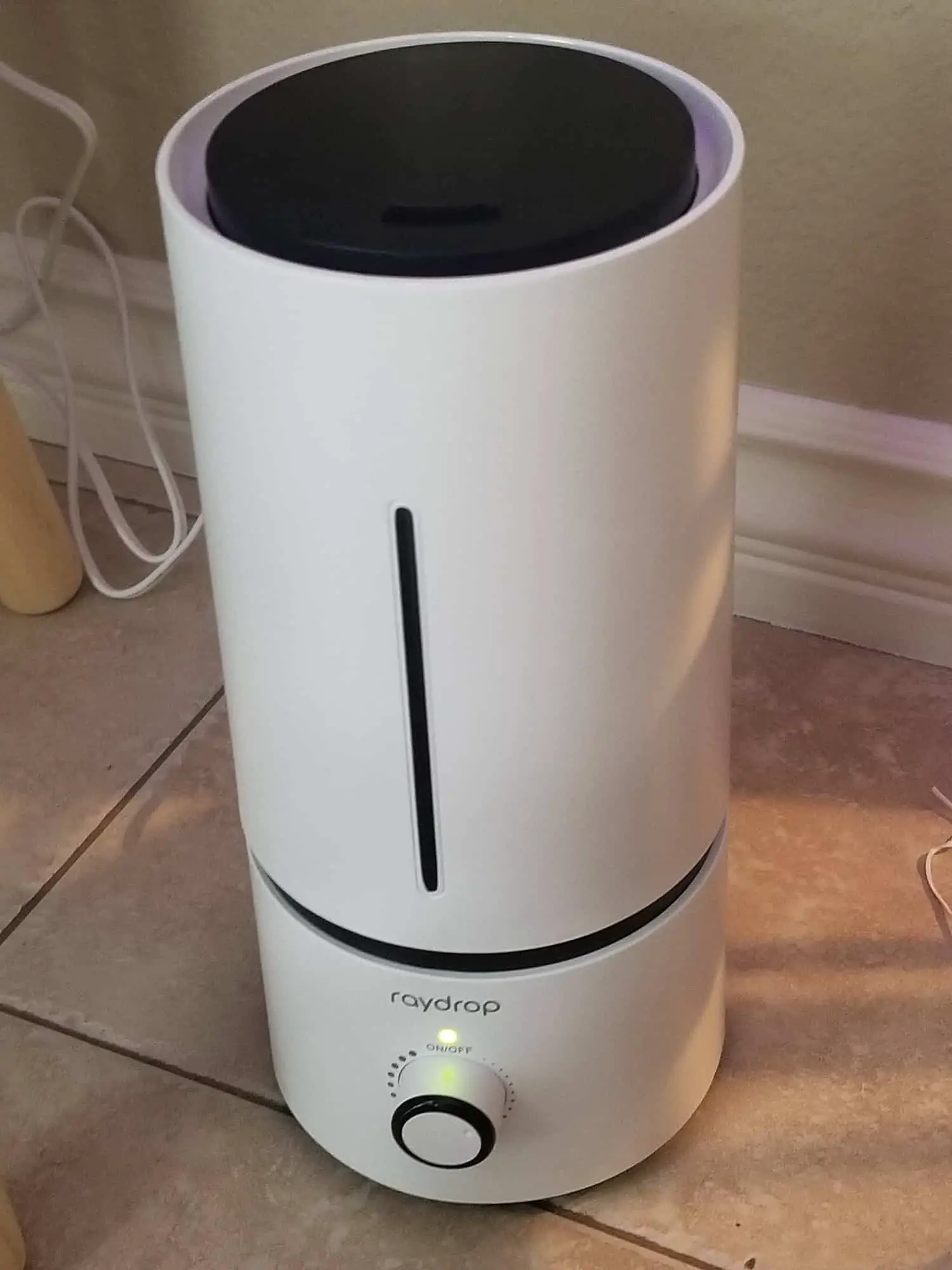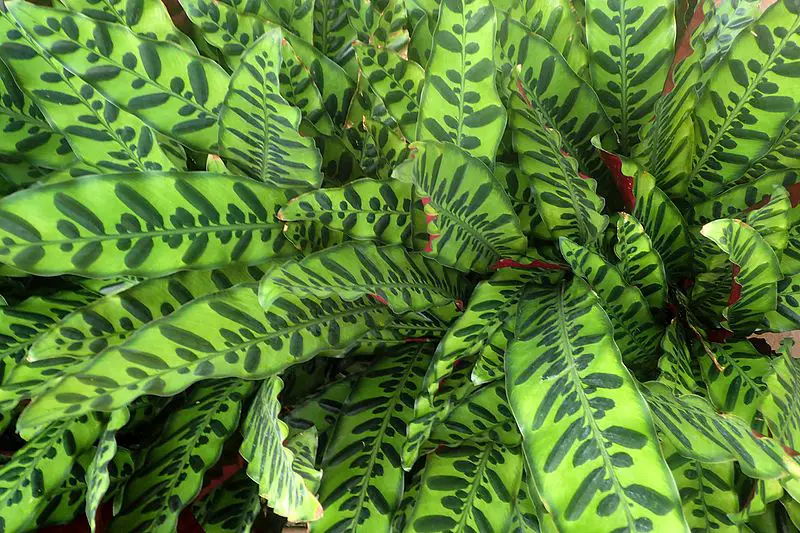Calathea lancifolia, which is commonly known as Rattlesnake Plant, is a plant that is popular for its tropical-looking foliage. The lance-shaped leaves are known for their beautiful patterns.
To care for Rattlesnake Plant, keep your plant in a location that is exposed to medium filtered light. During the growing season (May through August), keep the soil moist at all times. Outside of the growing season, allow the top one inch of soil to completely dry between watering sessions.
| Scientific Name | Calathea lancifolia |
| Common Name | Rattlesnake Plant |
| Lighting Requirements | Medium filtered light |
| Watering Requirements | Water lightly every couple of days in order to keep the soil constantly moist (not soaked) during the growing season (May-August). Outside of the growing season, allow the top 1″ of soil to completely dry between watering sessions. |
| Soil | 1 part peat-based potting soil, 1 part perlite |
| Fertilizer | Fertilize with an all-purpose fertilizer diluted to half strength every 4-6 weeks during the growing season. |
| Temperature | 65oF (18oC) to 85oF (30oC) |
| Humidity | 50% to 70% |
| Toxicity | Not toxic to dogs and cats |
The rest of this article will serve as a detailed care guide for Rattlesnake Plant.
About Rattlesnake Plant
Calathea lancifolia, which is commonly referred to as Rattlesnake Plant, is a species of plant belonging to the Prayer Plant family. Rattlesnake Plant is native to the tropical rainforests of Brazil. In its natural habitat, Calathea lancifolia blooms during the late spring or early summer. Unfortunately, Rattlesnake Plants grown indoors rarely flower. Rattlesnake Plants typically grow to be about 18 inches inches in size when grown indoors and 30 inches in size when grown outdoors.
Lighting Requirements For Rattlesnake Plant
Although Rattlesnake Plant is considered a “low-light” plant, it still needs some light to survive. Like other Calatheas, Rattlesnake Plant grows best in filtered medium light. If possible, put your Rattlesnake Plant near a north and east-facing windows. Direct sunlight or even bright indirect light from a south-facing window can cause scorched leaves. Unfortunately, scorch marks are permanent. Scorch marks are like scars in that the damage cannot be reversed. However, if the brown/yellow coloring is not spreading to other parts of the plant, the damage is probably cosmetic rather than a sign of a dying plant.
If the Rattlesnake Plant is exposed to excessive light for an extended period of time, the leaf pattern will begin to fade.
If the Rattlesnake Plant is not exposed to enough sunlight, the rate of plant growth will slow or stop altogether. Too little light can also cause leaf coloring to dull.
Do not be afraid to move your plant around and experiment with different spots within your home. When experimenting with light levels, it is important to inspect your plant regularly to observe how it responds to changes in light.
Temperature and Humidity Levels Suitable For Rattlesnake Plant
Ideal Temperature Range For Rattlenake Plant
Rattlesnake Plant does best in temperatures between 65oF (18oC) and 85oF (30oC). Avoid placing your Rattlesnake Plant next to drafty doors and windows because these plants are sensitive to sudden changes in temperature.
Humidity Levels Suitable For Rattlesnake Plant
While most tropical plants prefer humid conditions, Calatheas are particularly sensitive to low humidity. The plant’s leaves will get brown and crispy if it is in an environment that is too dry.
Most homes have an average relative humidity of 30 to 60 percent. To increase the humidity in the vicinity of your plant, I recommend purchasing a little humidifier near your Rattlesnake Plant. You can purchase a small humidifier on Amazon for under $25.

I have come across several sources that recommend misting your plants to compensate for dry conditions. Although misting can be therapeutic, it does not significantly increase the humidity and can cause fungal diseases. For this reason, I recommend not misting your plant.
Watering Rattlesnake Plant
Water your Rattlesnake Plant frequently enough to keep the soil moist (but not waterlogged) during the growing season (May through August). During the rest of the year, allow the top 1-inch of soil to completely dry between watering sessions.
Many people are intimidated by watering Rattlesnake Plants (and other Calatheas). However, your plant will often show signs of underwatering or overwatering. Signs of underwatering include curling leaves or the bottom leaves yellowing. If your plant shows signs of underwatering, simply increase the frequency of watering.
Signs of overwatering include drooping leaves and rotting stems. To save your Rattlesnake Plant from overwatering, begin by giving the plant a break from water until the roots and soil are dry. Then remove your plant from its pot and expose the roots by gently clearing away the soil. Use clean, sharp scissors or garden shears to cut off any dead or sick-looking roots. Healthy roots are white and firm while unhealthy roots are dark brown/black and mushy. After pruning the unhealthy roots, repot your Rattlesnake Plant in fresh soil.
The water you use for this plant is also important. Like other Calatheas, Rattlesnake Plant is sensitive to the chlorine and minerals commonly found in tap water. It is best to use rainwater or distilled water for your Rattlesnake Plant. Alternatively, use filtered water or leave tap water out for 8-12 hours in order to allow the chlorine to evaporate.
Best Soil For Rattlesnake Plant
Rattlesnake Plant will grow best in a soil mix that provides a good balance of water retention and drainage. Too much water retention could easily lead to an overwatering/root rot situation. On the other hand, too much drainage can cause the soil to lose moisture too quickly. For this reason, the best soil mix for Rattlesnake Plant is 2 parts peat-rich potting soil and 1 part perlite.
During the spring months, add some fresh soil to the top of your plant. Adding a handful of compost during the spring months is also a good practice. Compost is rich in nutrients that will help keep your plant healthy and growing.
Fertilizing Rattlesnake Plant
Like other types of Prayer Plant, Rattlesnake Plant will benefit from some fertilization. Regular fertilization helps your Rattlesnake Plant grow more quickly and improves the plant’s overall appearance. Fertilize your Rattlesnake Plant every 4 to 6 weeks during the spring and summer months with an all-purpose houseplant fertilizer diluted to half strength. Rattlesnake plants do not need to be fertilized during the winter.
A white crust, which is a build-up of soluble salts, forming on the soil surface is a sign of over-fertilizing. This negatively impacts plant health and can cause slow growth, yellow leaves, brown tips, or leaf drop. If you determine that your plant is suffering from over-fertilization, flush the excess minerals from the soil profile by watering your plant thoroughly.
Propagating Rattlesnake Plant
Like other Calatheas, it is easiest to propagate Rattlesnake Plant by division. The best time to propagate Rattlesnake Plant is when you are repotting during the spring. Carefully pull apart the plant at natural divisions and plant each divided section in its own pot.
Rattlesnake Plant can also be grown from seed. However, growing these plants from seed is more difficult than propagating by division.
Is Rattlesnake Plant Toxic?
According to the American Society for the Prevention of Cruelty to Animals (ASPCA), Rattlesnake Plant is non-toxic to dogs, cats, and horses.

